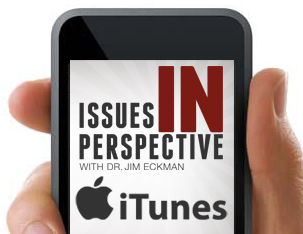The Crisis Of Manhood In American Culture
Dec 14th, 2024 | By Dr. Jim Eckman | Category: Culture & Wordview, Featured IssuesThe mission of Issues in Perspective is to provide thoughtful, historical and biblically-centered perspectives on current ethical and cultural issues.
![]()
Many times I have used this quote from G.K. Chesterton: “When men choose not to believe in God, they do not thereafter believe in nothing; they then become capable of believing in anything.” From Chesterton’s quote I am choosing to use “men” here as gender-specific—males in American culture today. There is so much confusion within our culture about what it means to be a man. As David French reports, the very definition of “masculinity” betrays a crisis. “In 2019, the American Psychological Association published guidelines that took direct aim at ‘traditional masculinity—marked by stoicism, competitiveness, dominance and aggression’—declaring it to be ‘on the whole, harmful.’” French correctly observes that “Competitiveness, aggression and stoicism surely have their abuses, but they can be indispensable in the right contexts when used for virtuous purposes.” As Richard V. Reeves, senior fellow in Economic Studies at the Brookings Institute notes in his indispensable book, Of Boys and Men: Why the Modern Male Is Struggling, Why It Matters, and What to Do About It, the phrase “toxic masculinity” is counterproductive. It teaches men there is something toxic inside them that needs to be exorcised. “The problem with men is typically framed as a problem of men,” Reeves writes. “It is men who must be fixed, one man or boy at a time. This individualist approach is wrong.” The major theme of his book is “The male malaise is not the result of a mass psychological breakdown, but of deep structural challenges.”
Christians should take note. If anything is well established in American social science, it is that men are falling behind women in higher education, suffer disproportionately from drug overdoses and are far more likely to commit suicide. Furthermore, boys in the United States are less prepared than young girls when they begin school and less likely to graduate from high school or finish college. Young men are falling out of the labor force. So-called deaths of despair—by suicide and drug overdose—are nearly three times as common among men as women. One out of every five fathers does not live with his children. In 1990, 3 percent of men reported having no close friends; now, 15 percent do.
Carlos Lozada observes that “[As] a scholar of class and inequality, Reeves instead sees men encumbered by structural problems in our society, and he has various policy fixes in mind. He wants to delay boys’ entry into kindergarten by one year, in part because their brains develop more slowly than those of girls. He wants to see more male teachers in kindergarten through 12th grade, because they serve as role models for boys and help improve their academic performance. (Men make up 24 percent of U.S. teachers, down from 33 percent in the early 1980s.) And at a time when automation and freer trade have transformed job markets, Reeves wants to create more opportunities for men in what he calls HEAL jobs—health, education, administration, literacy—which are typically dominated by women.”
Three lies now permeate our culture and define manliness and manhood in the US. Joe Ehrmann, former NFL defensive tackle and graduate of Dallas Seminary, has summarized these three lies:
- Real masculinity is determined by athletic ability, which means that you must have the size, strength, and ability to compete against other boys or men and win. Those who have athletic prowess have higher esteem and therefore have more value and worth and are more masculine.
- Being a man is all about sexual conquest. Using women for personal pleasure validates manhood. The more women a man “conquers” the more masculine he is.
- Economic success—the size of your salary and the power associated with job titles. The measure of that success and achievement then becomes the things one buys. The man with the more things is the more successful man.
Ehrmann concludes: “We have a country full of boys and men who have been deeply wounded by the culture and deeply wounded in their families due in large part to the problem of fathers who are missing in action.” These men then become violent or become passive and reclusive and then begin to fantasize with pornography—where the woman is always smiling, always welcoming and always “loving.” The woman of pornography never says “no” and is always there for the “taking.” Through the Internet or through magazines or books, men are therefore drawn in and become addicted to this fantasy world of pleasure and acceptance.
Who are the male role models today? Consider the recent presidential campaign. The Republican Party hosted the following at their national convention: Retired pro wrestler, Hulk Hogan; Dana White, chief executive of the Ultimate Fighting Championship; JD Vance focused on “childless cat ladies,” thereby clearly denigrating women; and Kid Rock sang and appeared on stage as well. These masculine “models” are rooted in grievance and anger.
Finally, consider the Joe Rogan phenomenon in 2024. His You Tube channel has 17 million subscribers. His podcast, The Joe Rogan Experience, which was launched in 2009, has held top spot on the Spotify charts consistently for the past five years. According to Helen Lewis of The Atlantic, “he records two or three episodes a week, each running to several hours. The former Democratic presidential candidate Andrew Yang, whose campaign for universal basic income went viral after a Rogan appearance five years ago, calls him ‘the male Oprah.’” Most of his fans are male, predominantly white, with a quarter Hispanic. Lewis writes that Rogan is “a guy who started a podcast in 2009 to smoke weed with his fellow comics and talk about marital arts—and who, like many Americans, has taken part in a great geographical sorting, moving to be closer to people who share values he shares. He speaks to people who feel silenced, both elite and normie . . . .”
What then does all this mean for the health of American men? It certainly is not evil that women are attaining higher levels of education, better paying jobs and making 85% of all buying decisions. The challenge is the effect all this has on men. God has designed the role relationships between men and women rather clearly. God created the human race male and female; and men and women are completely different, physically, emotionally, and psychologically. That is why imaginative play among little boys and girls is so radically different. That is why boys enjoy rough sports and girls do not. That is why women excel in some fields and men in others. But American culture is now driven by an ideology that seemingly ignores, indeed even mocks gender differences. The result today is that boys and men are suffering the consequences of this ideology. As men fail in their roles, women naturally pick up the slack. Men today are more confused and more disoriented than ever. As humans, we have the freedom to ignore or even flaunt those propositions, but then we must accept the consequences.
David French writes of Admiral William McRaven, Navy SEAL, former commander of US Special Operations Command and one of the architects of Operation Neptune Spear, the mission to kill Osama bin Laden. McRaven gave one of the most helpful, piercing descriptions of men as servant leaders: “You must have compassion. You must ache for the poor and disenfranchised. You must fear for the vulnerable. You must weep for the ill and infirm. You must pray for those who are without hope. You must be kind to the less fortunate.” This is not a message of grievance and anger. Nor is it the message of a male Oprah. It is the message American men need to hear—a strong, confident, trusting servant leader of the home, the church and the larger culture.
See David French in the New York Times (29 May 2023); Carlos Lozada in the New York Times (4 June 2023); David Brooks, “The Crisis of Men and Boys” in the New York Times (29 September 2022); Belinda Luscombe in Time (22 November 2010); Cheryl Wetzstein in the Washington Times (25 May 2011); Sabrina Tavernise in the New York Times (26 May 2011); Joe Ehrmann, “The Greatest Crisis in American Today: The Loss of True Masculinity and its Devastating Effects on Our Culture,” Veritas (October 2006), pp. 3-5; Helen Lewis, in The Atlantic (October 2024), pp. 80-86; and David French in the New York Times (29 July 2024).


